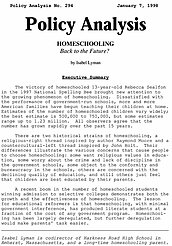The victory of homeschooled 13-year-old Rebecca Sealfon in the 1997 National Spelling Bee brought new attention to the growing phenomenon of homeschooling. Dissatisfied with the performance of government-run schools, more and more American families have begun teaching their children at home. Estimates of the number of homeschooled children vary widely; the best estimate is 500,000 to 750,000, but some estimates range up to 1.23 million. All observers agree that the number has grown rapidly over the past 15 years.
There are two historical strains of homeschooling, a religious-right thread inspired by author Raymond Moore and a countercultural-left thread inspired by John Holt. Their differences illustrate the various concerns that cause people to choose homeschooling: some want religious values in education, some worry about the crime and lack of discipline in the government schools, some object to the conformity and bureaucracy in the schools, others are concerned with the declining quality of education, and still others just feel that children are best educated by their parents.
A recent boom in the number of homeschooled students winning admission to selective colleges demonstrates both the growth and the effectiveness of homeschooling. The lesson for educational reformers is that homeschooling, with minimal government interference, has produced literate students at a fraction of the cost of any government program. Homeschooling has been largely deregulated, but further deregulation would make parents’ task easier.
About the Author

This work is licensed under a Creative Commons Attribution-NonCommercial-ShareAlike 4.0 International License.
